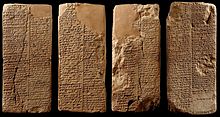Erra-imitti
| Erra-Imittī | |
|---|---|
| King ofIsin | |
 | |
| Reign | 8 regnal years 1868-1861 BC (MC) 1805–1799 BC (SC) |
| Predecessor | Lipit-Enlil |
| Successor | Enlil-bâni |
| House | 1st Dynasty of Isin |
Erra-Imittī,(cuneiform:dèr-ra-i-mit-ti[i 1]orèr-ra-ZAG.LU[i 2]meaning “Support ofErra”[1]) ca. 1805–1799 BC (short chronology) or ca. 1868–1861 BC (middle chronology),[2]was king ofIsin,modern Ishan al-Bahriyat, and according to theSumerian King Listruled for eight years. He succeededLipit-Enlil,with whom his relationship is uncertain and was a contemporary and rival ofSūmû-ElandNūr-Adadof the parallel dynasty ofLarsa.He is best known for the legendary tale of his demise, Shaffer’s “gastronomic mishap”.[3]
Biography[edit]
He seems to have recovered control ofNippurfrom Larsa early in his reign but perhaps lost it again, as its recovery is celebrated again by his successor. The later regnal year-names offer some glimmer of events, for example “the year following the year Erra-Imittī seizedKisurra"[nb 1](the modern site of Abū-Ḥaṭab) for the date of a receipt for a bridal gift and “the year Erra-Imittī destroyed the city wall of Kazallu,”[nb 2][4]a city allied with Larsa and antagonistic to Isin and its ally,Babylon.His conquest of Kisurra would have been a significant escalation of hostilities against Isin's rival Larsa.[5]Ahaematitecylinder seal[i 3]of his servant and scribe Iliška-uṭul, son of Sîn-ennam, has come to light from this city, suggesting prolonged occupation.[6]The latest attested year-name gives the year he built the city wall ofgan-x-Erra-Imittī,perhaps an eponymous new town.
When the omens predicted impending doom for a monarch, it was customary to appoint a substitute as a "statue though animate",[nb 3]a scape-goat who stood in the place of the king but did not exercise power for a hundred days to deflect the disaster, at the end of which the proxy and his spouse would be ritually slaughtered and the king would resume his throne.[7]TheChronicle of Early Kings[i 2]relates that:
dÈr-ar-zà.dib lugaldEn-l íl-dùlúnu.kiri6
a-na nu nì.sag.gileinagišgu.za-šú ú-še-šib
aga lugalti-šúina sag.du-šú iš-ta-kan
dÈr-ra-i-mit-ti ina é.gal-šú pap-pa-su im-me-tú in sa-ra-pi-šú im-tu-ut
dEn-l íl-dù šá ingišgu.za ú-ši-bi ul it-biim-tu-ut
a-na lugalú-tiit-taš-kan
Translation: King Erra-imittī ordered Enlil-bâni, the gardener, to sit on the throne as a royal substitute (and) put the crown of kingship on his head. Erra-imittī died in his palace while swallowing hot porridge[nb 4]in little sips.Enlil-bâni,who sat on the throne, did not resign and was elevated to the royal office.[8]— Chronicle of early kings, after Glassner but with correction
Presumably his error was to remain in the palace while the substitute ceremony was conducted. While the tale may be apocryphal, it provides a literary demarcation between dynasties.[9]He was succeeded byIkūn-pî-Ištar,according to two variant copies of theSumerian King List,or Enlil-bâni, if the other sources are correct.[8]
Inscriptions[edit]
Notes[edit]
External links[edit]
References[edit]
- ^Imittu D in CAD i-j p. 126b “support”
- ^D. O. Edzard (1999). Erich Ebeling, Bruno Meissner (ed.).Reallexikon der Assyriologie und Vorderasiatischen Archäologie: Ia - Kizzuwatna.Vol. 5. Walter De Gruyter Inc. p. 170.
- ^Aaron Shaffer (1974). "Enlilbani and the 'Dog House' in Isin".Journal of Cuneiform Studies.26(4): 251.JSTOR1359444.
- ^Anne Goddeeris (2009).Tablets from Kisurra in the Collections of British Museum.Harrassowitz. p. 16.
- ^Trevor Bryce (2009).The Routledge Handbook of The Peoples and Places of Ancient Western Asia.Routledge. p. 391.
- ^Douglas Frayne (1990).Old Babylonian Period (2003-1595 B.C.): Early Periods, Volume 4.University of Toronto Press. p. 76.
- ^Karen Rhea Nemet-Nejat (1998).Daily Life in Ancient Mesopotamia.Greenwood Press. p.189.
- ^abJean-Jacques Glassner(2005).Mesopotamian Chronicles.SBL. p. 271.
- ^William W. Hallo (1990). "The Limits of Skepticism".Journal of the American Oriental Society.110(2): 189.JSTOR604525.
